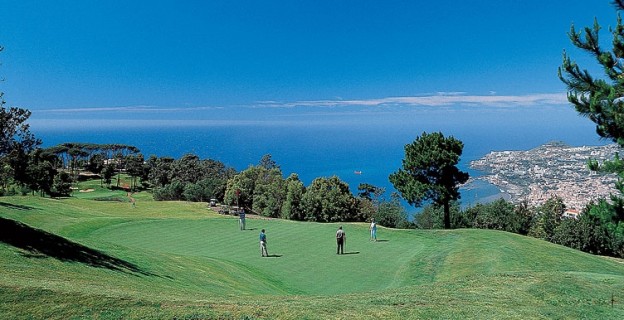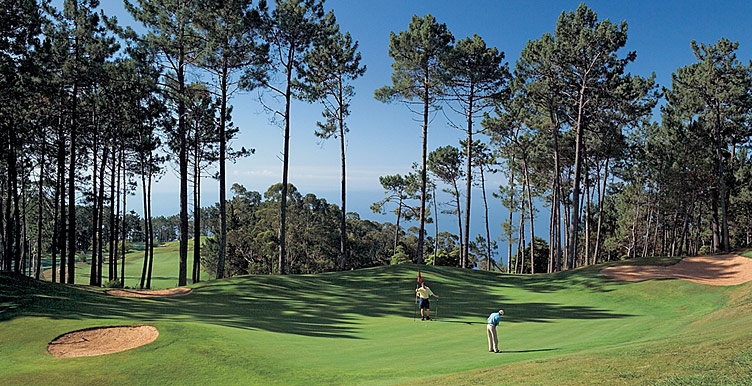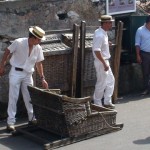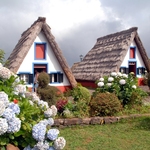“Remember Andy, the greens here always slope towards the sea.” I was being reminded about this again by my playing partner, who knew every inch of this fabulous course, as I sized up yet another tricky putt, I suppose a little sigh was not out of order given the situation I found myself in.
Golf is a tricky game under normal circumstances, what with our consistent preference to hit the ball just about anywhere except where it’s supposed to go, but when there’s the added complication of playing a course that’s over 1,000 feet above sea level and doesn’t have a flat spot on any part of it, you can be forgiven for feeling some trepidation.
Palheiro
Palheiro Golf Club is truly extraordinary. Seemingly carved straight out of the volcanic rock that rises majestically thousands of feet above Madeira’s beautiful Atlantic coastline, the fairways and greens slope in all directions and each hole is a mini-adventure in its own right. It’s not a long course, not by any stretch of the imagination, because it simply doesn’t need to be. You don’t need power to play Palheiro, what you need is guile and craft to strategically plot your way around it and enough sensory capacity to take in all the glorious views that surround you. You might also want to take a buggy!
Why Madeira has remained under our radar for so many years is a real mystery to me. It’s tropical fauna, fine weather, fantastic cuisine, rich culture and gentlefolk have been delighting people in the know for centuries. Just off the coast of Africa, not a million miles from the Canaries, Madeira’s well known enough for its fine wine, but try a toboggan down Funchal’s steep streets, or take a walk along the thousand-odd scenic miles of ancient Levada networks, the water channels that bring water down from the north of the island to the drier south, and you soon realise the island has much to offer. Funchal, the capital, stretches upwards from its glorious bay thousands of feet, and thankfully, there are cable cars to get you up to the higher parts, but you still wonder at the little terracotta-roofed houses and villas that sit perilously close to the abyss.
Madeira maybe only 30 miles long and 12 miles wide but they say that you can get all four seasons in one day here. The truth is that there is an extraordinary microclimate on the island that ensures that every few miles the weather can be very different. It may well be hot and sunny in Funchal yet just a few miles along the coast it’s windy and overcast. Or vice versa of course!
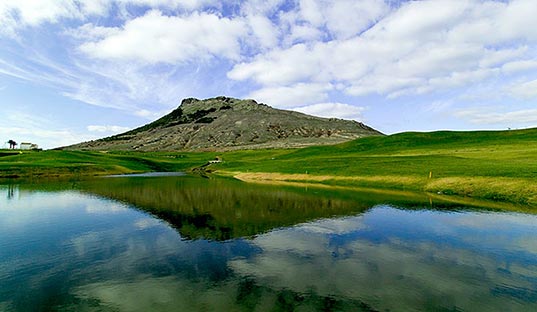
There are three courses to play here. There are two on Madeira, the 18 hole Palheiro Course and 27 holes at Santo de Serra although a third course is nearing completion on the north side of the island. There’s also another 18 holes on Porto Santo, Madeira’s sister island some 40 miles and a ferry ride away, which has hosted the Madeira Open for the last two years.
So, back to the Paleirho then, and that tricky putt. The weather gods had decreed it to be windy, and I swear that but for a sudden gust my ball was destined for the hole. Despite that missed putt, the course was a delight to play, particularly the devious 4th, the uphill 12th and holes 15, 16 and 17, the ‘Amen Corner’ triangle.
Set amongst a 200-year-old still private estate that also offers beautiful tropical gardens and a five-star hotel, Palheiro is a stunning example of how a course with no water hazards or long holes, can still be a devilishly difficult challenge. I can’t wait to play it again.
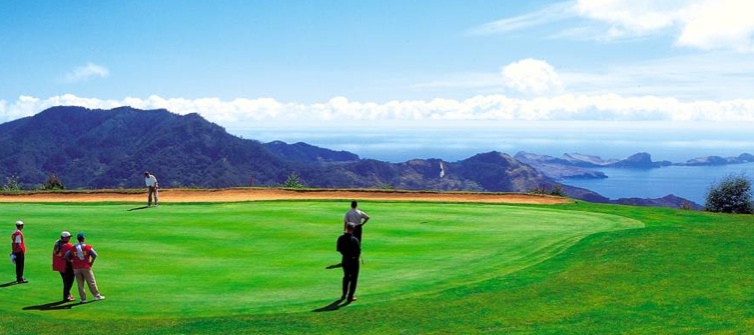
Santo da Serra
Santo da Serra is as different from Palheiro as chalk is to cheese. Designed by none other than the great Robert Trent Jones, the three links of nine holes each offers you a different challenge, although the Machico and the Desertas courses are the championship combination, having hosted the Madeira Open on numerous occasions. Both tracks meander down from the clubhouse’s lofty perch through a valley and eventually steeply back up again. The flatter Serras course some 200 metres shorter is deemed to be less difficult, but will I can assure you, still prove to be a tough test with greens that are so difficult to read. Something that is consistent with all the courses in Madeira.
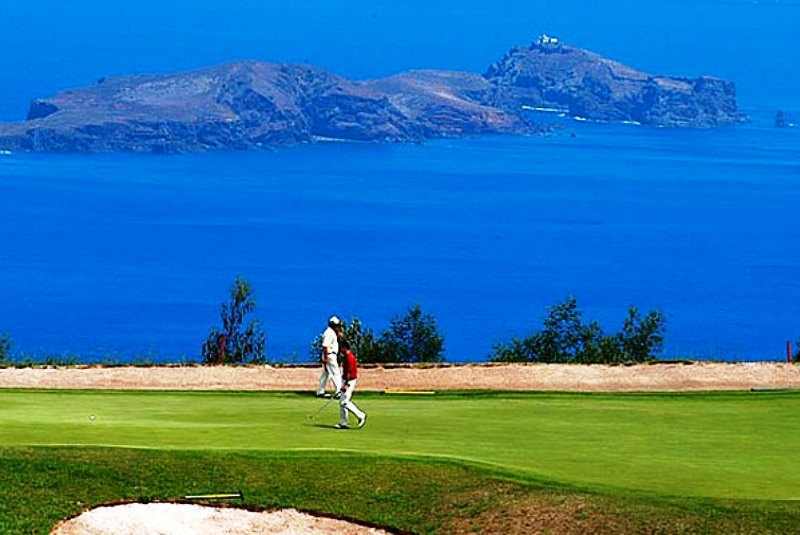
Machico’s first few holes are majestic, sweeping across huge valleys and cliff tops and in particular the long par 5 third that doglegs around a ravine and the signature 4th , a par 3 that has one of those hit and hope shots over the same ravine to a green tucked right into the cliff edge with nothing but the Atlantic surf awaiting below. The uphill 9th is so steep that an under-hit second could well see your ball returning gently back to you.
The Desertas course is aptly named with the first two holes offering up some stunning high views of the deserted nature reserve archipelago that makes up the Desertas Islands in the distance. This nine has more water to contend with than the Mochico but the mountainous terrain and the uphill final hole is still unrelenting torture. In true Trent Jones style, the greens and fairways are always guarded by strategically placed cunningly shaped bunkers. The fourth hole dog leg will probably be one of the hardest drives you will ever have to make with a very narrow landing area and huge trouble to the right.
Porto Santo Golf Club
Porto Santo Golf Club is a pretty remarkable place. On an island only 8 miles long and 3 miles wide, the 18 hole championship course almost cuts through the entire middle of it, with a 9 hole par 3 course too and yet another 18 holes planned to be built in the near future. This development has been designed by the great Seve Ballesteros, and unlike Madeira’s courses, the lack of trees here gives it a real links feel. Water is scarce as it hardly ever rains, so ingeniously, the course is irrigated using a combination of desalinated seawater and – wait for it – treated human waste from the island’s sewage system! The championship course which has hosted the Madeira Open for the last two years is made up of two quite different stretches although, with water so scarce, it’s surprising that there are so many water featured holes, but that’s Seve for you.
 The front nine is long, particularly the 225-yard par 3 seventh and 570-yard uphill par 5 and for the most part is played inland. It’s when you get to the back nine that the course comes alive with some stunning coastal holes. The 10th is a very tricky par 5 with water everywhere, and then the 13th, 14th, and 15th are set along the very cliff edge with the Atlantic pounding the rocks far below. The par 3 13th is particularly terrifying with a make or break shot over the cliffs to a green literally carved into the cliff edge. The final hole was also pretty memorable as with the wind behind, I nailed a drive a 100 miles down the par 5 fairway only to be faced with a steep downhill second to a huge lake guarding a sloping stepped green that was still a long iron in.
The front nine is long, particularly the 225-yard par 3 seventh and 570-yard uphill par 5 and for the most part is played inland. It’s when you get to the back nine that the course comes alive with some stunning coastal holes. The 10th is a very tricky par 5 with water everywhere, and then the 13th, 14th, and 15th are set along the very cliff edge with the Atlantic pounding the rocks far below. The par 3 13th is particularly terrifying with a make or break shot over the cliffs to a green literally carved into the cliff edge. The final hole was also pretty memorable as with the wind behind, I nailed a drive a 100 miles down the par 5 fairway only to be faced with a steep downhill second to a huge lake guarding a sloping stepped green that was still a long iron in.
Madeira’s courses are a joy to play, not only because of the irresistible difference each one offers but also because there just aren’t that many people playing them. These days, finding championship courses without any crowds is something of a rarity, so try them quick before word gets out. Week-long passes can be bought for around €300.
Tell me more about Golf in Madeira

